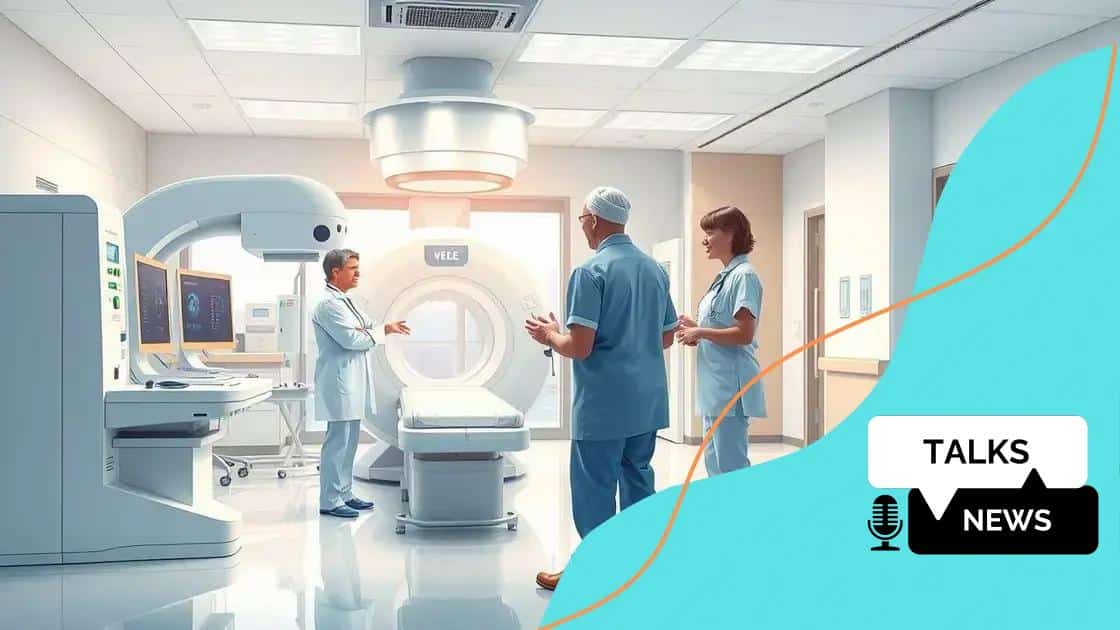Veterans’ healthcare improvements and modernization efforts

Veterans’ healthcare improvements and modernization involve integrating technology, enhancing mental health services, and fostering community support to provide tailored, comprehensive care for those who have served.
Veterans’ healthcare improvements and modernization are critical topics today as they aim to enhance the quality of care for those who served our nation. How these changes affect veterans can truly reshape their experiences with healthcare.
Current challenges in veterans’ healthcare
Veterans’ healthcare faces numerous challenges today that impact the quality of care provided to those who served. Identifying these challenges is the first step toward meaningful improvements.
Access to Care
Many veterans struggle to access healthcare services due to geographical disparities and limited availability of facilities that cater specifically to their needs. In rural areas, for instance, the nearest healthcare provider might be hours away, complicating routine and emergency care.
- Transportation issues hinder regular check-ups.
- Long wait times can discourage veterans from seeking help.
- Telehealth services are often underutilized in remote locations.
Mental Health Services
The demand for mental health services among veterans continues to rise. Many veterans face challenges such as PTSD and depression, yet stigma around seeking help remains prevalent. This stigma can lead to a reluctance to engage in vital therapy options.
Providing comprehensive support for mental health is crucial, as many veterans not only need access to services but also a supportive environment that encourages them to pursue treatment.
Furthermore, the integration of mental health into primary care is essential. When healthcare providers focus on both physical and emotional health, they can provide a more holistic approach to veterans’ wellness.
Healthcare Policies
Changing policies related to veterans’ healthcare can sometimes lead to confusion or gaps in service delivery. Veterans may be unsure of their benefits or how to access different types of care. This complexity can lead to frustration and unmet needs.
- Clear communication of policy changes is necessary.
- Veteran organizations can help bridge the gap.
- Training for healthcare providers on veterans’ unique needs improves care.
Emerging technology and improved services can alleviate some of these challenges. By enhancing communication and providing better access to information, we can address the needs of our veterans more effectively. Moreover, as healthcare options expand, it is essential to ensure that they are tailored to meet the unique requirements of those who have served.
Technological advancements in patient care
Technological advancements in patient care are transforming how veterans receive healthcare. Innovations are making it easier for veterans to access the services they need while improving the quality of care.
Telehealth Services
Telehealth has emerged as a vital resource for veterans, allowing them to connect with healthcare professionals without needing to travel. This is especially important for those living in remote areas. With video consultations, veterans can receive timely consultations and follow-ups from the comfort of their homes.
- Increased accessibility to specialists.
- Reduction in travel-related stress and costs.
- Convenient scheduling options for appointments.
Wearable Health Devices
Wearable health devices, such as fitness trackers and smartwatches, provide real-time health monitoring. Veterans can track their vital signs, physical activity, and sleep patterns. This information can help healthcare providers understand patients’ needs more clearly.
By analyzing data from these devices, doctors can make informed decisions about treatment plans and early interventions. This kind of proactive care can lead to significantly better health outcomes for patients.
Electronic Health Records (EHR)
Electronic health records have revolutionized how patient information is stored and shared. With EHR, veterans’ medical histories are easily accessible to authorized healthcare providers. This means that veterans do not have to repeat their health histories during each visit, which saves time and reduces frustration.
- Streamlined communication between providers.
- Improved patient safety through accurate data.
- Seamless integration of services across different healthcare systems.
As we explore these technological changes, it is clear that they are paving the way for more efficient and effective healthcare for veterans. Each advancement plays a crucial role in ensuring that our heroes receive the best possible care.
The role of telehealth in veterans’ services

The role of telehealth in veterans’ services has gained recognition in recent years. It provides a necessary link between veterans and their healthcare providers, especially for those who may find it difficult to access traditional healthcare settings.
Improving Accessibility
Telehealth improves access for veterans who live in rural areas or who have mobility challenges. With virtual appointments, they can get the care they need from home. This reduces the barriers that may prevent them from seeking help.
- Less travel time and associated costs.
- Access to specialists who may not be locally available.
- Comfortable environment that can reduce anxiety during consultations.
Continuity of Care
Telehealth ensures that veterans receive continuous care, especially in managing chronic conditions. Regular virtual check-ins can help keep track of a veteran’s progress and any emerging health issues. By utilizing technology, healthcare providers can monitor patients more effectively.
A seamless approach to care can make all the difference. For instance, remote monitoring devices allow veterans to share real-time data with their doctors, enabling proactive management of their health.
Mental Health Support
Telehealth has also become essential in providing mental health services. Veterans facing mental health challenges often benefit from therapy in a familiar setting. Virtual therapy options can help address issues like PTSD, depression, and anxiety without the stigma that sometimes comes with in-person visits.
- Increased privacy for veterans seeking help.
- Flexible scheduling options to fit their lives.
- Quick access to mental health resources during a crisis.
As we see the integration of telehealth into veterans’ services, it becomes clear that this technology enhances the overall healthcare experience. By making care more accessible and continuous, telehealth meets the unique needs of veterans.
Community support initiatives for veterans
Community support initiatives for veterans play a crucial role in enhancing the lives of those who have served. These programs offer various resources and services that foster a sense of belonging and ensure that veterans receive the help they need.
Local Veteran Organizations
Many local organizations are dedicated to supporting veterans. These groups often provide essential services, from financial aid to mental health support. They help connect veterans with resources tailored to their specific needs. Community members can play a vital role in these initiatives by volunteering their time and skills.
- Support for job placement and training.
- Networking opportunities with other veterans.
- Assistance with navigating benefits and entitlements.
Peer Support Groups
Peer support groups allow veterans to connect with others who understand their experiences. These groups provide a safe space to share challenges and triumphs. By talking openly with peers, veterans can build a support network that encourages healing and growth.
Programs may focus on specific issues such as PTSD, rehabilitation, or reintegration into civilian life. Engagement in such groups can help reduce feelings of isolation.
Outreach Programs
Outreach initiatives are designed to raise awareness about the issues veterans face. These programs often include events and workshops that inform the community about the importance of supporting veterans. They encourage public involvement in recognizing and addressing the needs of veterans.
- Health and wellness fairs.
- Educational seminars on veteran-related issues.
- Cultural events to honor veterans’ contributions.
Community support not only strengthens veteran services but also fosters a sense of unity. By working together, communities can create safer and more welcoming environments for veterans, reminding them they are valued and respected.
Future outlook for veterans’ healthcare
The future outlook for veterans’ healthcare shows promising advancements and a commitment to improving services for those who have served. As society becomes more aware of veterans’ unique needs, innovative solutions are emerging.
Integration of Technology
One of the most significant changes expected is the continued integration of technology into veterans’ healthcare. Innovations like artificial intelligence and predictive analytics can streamline processes and improve patient outcomes. By analyzing data, healthcare providers can identify trends and customize care plans for individual veterans.
- Enhanced data sharing between facilities.
- Remote monitoring for chronic conditions.
- AI-driven support tools for healthcare professionals.
Holistic Care Approaches
Future healthcare models are also shifting toward holistic care, which addresses both physical and mental health. A comprehensive approach considers the emotional, social, and behavioral aspects of health alongside traditional medical treatments.
This shift recognizes the importance of mental health services, including therapy and counseling. By emphasizing mental well-being, veterans can receive better-rounded care that truly addresses their needs.
Community Partnerships
Collaboration between healthcare providers, community organizations, and government agencies will be vital in improving veterans’ healthcare. Building strong partnerships can create more comprehensive support networks and resources for veterans.
- Increased access to local support programs.
- Shared resources for healthcare education.
- Combined efforts to advocate for veterans’ rights and needs.
As these changes unfold, veterans can look forward to healthcare systems that are more responsive and tailored to their unique experiences. This proactive shift signifies a commitment to honoring veterans not only for their service but also through their ongoing care.
In conclusion, the improvements and modernization in veterans’ healthcare are crucial steps forward for those who have served. With technological advancements, community support, and a focus on holistic care, veterans can look forward to receiving better services tailored to their unique needs. As we embrace these changes, it becomes essential for all members of society to contribute to this journey. Together, we can ensure that veterans receive the honorable care they deserve.
FAQ – Frequently Asked Questions about Veterans’ Healthcare Improvements
What are some technological advancements in veterans’ healthcare?
Technological advancements include telehealth services, wearable health devices, and electronic health records that enhance care delivery and accessibility.
How does community support aid veterans?
Community support, such as local organizations and peer support groups, provides essential resources and fosters a sense of belonging among veterans.
What role does mental health play in veterans’ healthcare?
Mental health is crucial, focusing on services like therapy and counseling to address issues such as PTSD and depression, ensuring a holistic approach to care.
What does the future hold for veterans’ healthcare?
The future includes enhanced technology integration, community partnerships, and a continued focus on holistic care to meet the unique needs of veterans.





